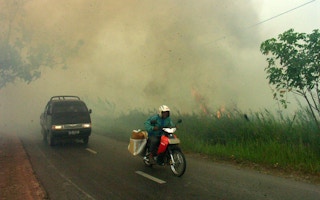Earlier this week, Indonesia’s parliament ratified the ASEAN Agreement on Transboundary Haze Pollution—12 years after first signing the agreement to reduce haze pollution from land and forest fires in Southeast Asia. The ratification of the treaty, combined with Singapore’s new Transboundary Haze Pollution Act, sends a clear and overdue signal that illegal land and forest fires in Indonesia, and the resulting regional haze pollution, will no longer be tolerated.
To continue reading, subscribe to Eco‑Business.
There's something for everyone. We offer a range of subscription plans.
- Access our stories and receive our Insights Weekly newsletter with the free EB Member plan.
- Unlock unlimited access to our content and archive with EB Circle.
- Publish your content with EB Premium.
Ratification of the law comes not a moment too soon. This week, fires flared across southern Sumatra and West and Central Kalimantan, jeopardizing Indonesia’s forests and the communities and wildlife that call these regions home. And because a tropical cyclone altered the wind direction, haze and smoke returned again to Singapore. Readings of the Pollutant Standards Index (PSI) surged to unhealthy levels, drawing international attention.
You can view near-real time information on the fires, concessions, wind direction, and more on Global Forest Watch Fires (GFW Fires), a fire-monitoring platform developed by WRI, Indonesia’s National REDD+ Agency (BP REDD+), DigitalGlobe, Google, Esri, and other partners. Read on for more analysis of Indonesia’s fires, and how new laws could help crack down on illegal burning.
Fires spike in Sumatra and Kalimantan
“
As with other regulations, the effectiveness of the newly ratified ASEAN treaty will depend on the quality of enforcement. But with near-real time monitoring tools such as GFW Fires at hand and the momentum mounting to crack down on illegal burning, the future’s skies may be looking brighter.
While fires are typically present in Indonesia during the dry season, this week saw a significant jump in the number of fire alerts. Data from GFW Fires shows 358 high-confidence fire alerts across Sumatra and 527 high-confidence fire alerts across Kalimantan over the past seven days. Sixty-six percent of the fire alerts occurred within the boundaries of oil palm, logging, and pulpwood concessions.
The number of fires is a noticeable increase when compared to the past few weeks, especially for the provinces of Central and West Kalimantan, and for Southern Sumatra (see Figure 1). In a pattern different from the last two major fire outbreaks in June 2013 and February and March 2014, the number of fire alerts in Riau Province was lower than in surrounding regions.
Will Singapore’s new laws help reduce fires?
Illegal burning—often associated with logging, timber, and oil palm concessions, or with conflicts over those areas—has long been a problem in Asia, particularly in Indonesia. The new Singapore law permits the government to prosecute and fine companies responsible for fires causing pollution in Singapore—regardless of which country the company is currently operating in—when pollution index readings remain over 100 for 24 hours or more. Air quality readings exceeded this limit for much of the day on September 15, but have since improved following a shift in wind direction. The law also allows Singaporeans to bring civil cases against those causing haze—for example, due to damage to a hotel’s revenue or a person’s health.
The real-time wind direction and air quality data on Global Forest Watch Fires suggests that earlier in the week, southerly winds from Sumatra were bringing smoke and haze through Singapore, though the latest wind direction maps seem to indicate that smoke and haze from Kalimantan may be transported to Singapore as well (check the data on GFW Fires here; air quality data is updated hourly, and wind direction is updated four times a day.)
The Singaporean government can investigate companies operating in those regions and, if illegal burning is present, take action under the Transboundary Haze Pollution Act. (You can view a list of oil palm, wood fiber, and timber concessions with the highest number of fire alerts on GFW Fires, or refer to Figure 5 at the end of this blog.)

A shift to southerly wind patterns brought smoke and haze to Singapore on September 15, when air pollution spiked in Singapore.
Potential impacts of Indonesia’s ratification of the haze treaty
Indonesia’s Parliament vote to ratify the ASEAN cross-border haze treaty represents the culmination of many efforts to improve fire monitoring in the country.
While the specific articles in the transboundary haze bill are largely already incorporated in Indonesia’s existing regulations aimed at reducing fires and illegal burning, it could create added pressure to enforce those laws. Despite a long history of rampant illegal burning, recent events show that Indonesia is taking the fires more seriously. Outgoing President Susilo Bambang Yudhoyono recently tasked Indonesia’s National REDD+ Agency (BP REDD+) to strengthen efforts on coordination across the government to address fires. The agency, working with other branches of government, established a “situation room” for fire response. By using real-time tools like GFW Fires, it’s working to reduce fire response time by 80 percent, from 30 hours or more down to two to four hours. Industry has also been stepping up. In June, the Roundtable on Sustainable Palm oil (RSPO) became the first commodity certification body to publicly share the boundaries of their certified production areas, allowing others to monitor fires in those concessions.
As with other regulations, the effectiveness of the newly ratified ASEAN treaty will depend on the quality of enforcement. But with near-real time monitoring tools such as GFW Fires at hand and the momentum mounting to crack down on illegal burning, the future’s skies may be looking brighter.
Susan Minnemeyer is WRI’s Geographic Information Systems (GIS) Lab Manager. This post originally appeared on the World Resources Institute’s Insights blog.















